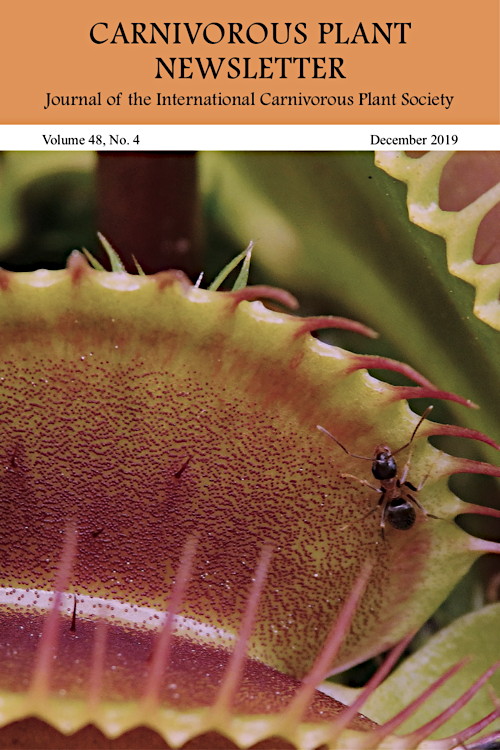 Dionaea traps selectively allow small animals to escape. Dionaea traps selectively allow small animals to escape.
Siegfried R. H. Hartmeyer, Irmgard Hartmeyer, Stephen E. Williams (2019). Carnivorous Plant Newsletter Vol. 48/4: 153-160.
Keywords: Dionaea muscipula, prey capture, Lasius neglectus, statistics
Jetzt verfügbar / now available: Der vollständige Text / Full text (PDF)

Abstract:
Dionaea muscipula selectively allows small animals to escape using a system of inter-locking features that complement each other very efficiently. Ants of the species Lasius neglectus(length 3.5 mm) ran through open traps, pausing on the alluring glands along the rim of the trap moving their mouthparts over them. Analysis of videos revealed the ants primarily passed along the trap rim, over the alluring glands, but sometimes ran down to the leaf base through the trigger hairs occasionally brushing by a hair without triggering the trap, because they did not deliver the two stimuli needed to trigger trap closure.Traps observed for four weeks were estimated from sampled observations to have had a total of about 15,000 trap visits by ants during this time period. Six ants were captured during four weeks in-dicating a risk of capture of about 0.04%. During this same period ten prey other than ants were cap-tured. Visits for prey other than ants was mostly nocturnal and so low that no visits were observed during the observation period. Compared with the large number of ant visits all other prey visits were orders of magnitude fewer. The selective system that allows small animals to escape includes:1) Attraction of the ants away from the trigger hairs by alluring glands.2) Clear visibility of the trigger hairs to a 3.5 mm ant.3) The requirement of two stimuli for triggering trap closure.4) The escape allowed for small animals by openings between the marginal bristles during the slower phase of trap closure that follows the rapid snap of the trap.Since ants are known to compose about one third of the captures by Dionaea in its native habitat, selection against the capture of small ants not worth the energy expenditure by the plant is an adap-tive mechanism.
|
Deutsche Übersetzung ... demnächst.
|
References:
Brown, W.H. 1916. The mechanism of movement and the duration of the effect of stimulation in the leaves of Dionaea. American Journal of Botany 3(2): 68-90.
Bundesministerium für Gesundheit (BMG 2007). Sachverständigenrat zur Begutachtung der Entwicklung im Gesundheitswesen. Kooperation und Verantwortung. Voraussetzungen einer zielorientierten Gesundheitsversorgung. Gutachten 2007, Langfassung, 2007 1-462. http://dipbt.bundestag.de/dip21/btd/16/063/1606339.pdf
Darwin, C. 1875. Insectivorous Plants. John Murray, London.
Davis, A.L., Babb, M.H., Lowe, M.C., Yeh, A.T., Lee, B.T., and Martin, C.H. 2019. Testing Darwin’s hypothesis about the wonderful Venus flytrap: Marginal spikes form a “horrid prison” for moderate-sized insect prey. The American Naturalist 193: 309-317.
Hartmeyer, S.R.H., and Hartmeyer, I. 2019. Video: Dionaea traps selectively allow small animals to escape. https://youtu.be/JJYAa0n_h0w
Hutchens, J.J., and Luken, J.O. 2009. Prey capture in the Venus flytrap: collection or selection? Botany 87:1007-1010.
Jones, F.M. 1923. The most wonderful plant in the world. Natural History 23(6): 589-596.
Juniper, B.E., Robins, R.J., and Joel, D.M. 1989. The Carnivorous Plants. Academic Press, London.
Jürgens, A., El-Sayed, A.M., and Suckling, D.M. 2009. Do carnivorous plants use volatiles for at-tracting prey insects? Functional Ecology 23: 875-887.
Kreuzwieser, J., Scheerer, U., Kruse, J., Burzlaff, T., Honsel, A., Alfarraj, S., Georgiev, P., Schnitzler, J.-P., Ghirardo, A., Kreuzer, I., Hedrich, R., and Rennenberg, H. 2014. The Venus flytrap attracts insects by the release of volatile organic compounds. Journal of Experimental Botany 65(2): 755-766.
Lichtner, F.T., and Williams, S.E. 1977. Prey capture and factors controlling trap narrowing in Dionaea (Droseraceae). American Journal of Botany 64(7): 881-886.
Luken, J.O. 2019. The Venus flytrap: Subsistence or trophy hunter? Natural History 127(5): 14-15.
Lloyd, F.E. 1942. Carnivorous Plants. Chronica Botanica Company, Waltham.
Pavlovic, A., Demko, V., and Hudák, J. 2010. Trap closure and prey retention in Venus flytrap (Dionaea muscipula) temporarily reduces photosynthesis and stimulates respiration. Ann Bot. 105(1): 37-44.
Williams, S.E., and Hartmeyer, S.R.H. 2017. Prey capture by Dionaea muscipula A review of scien-tific literature with supplementary original research. Carniv. Pl. Newslett. 46(2): 44-61.
|
|
